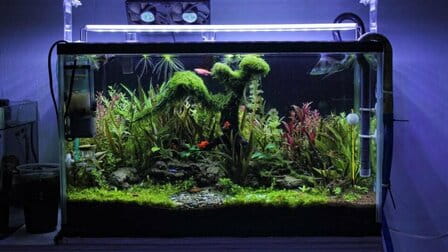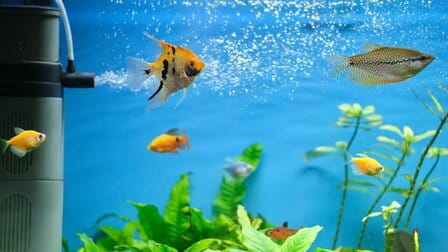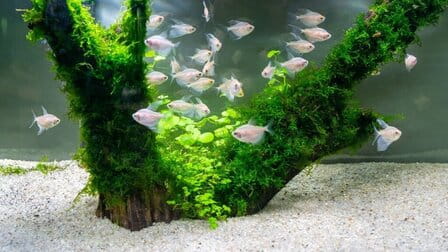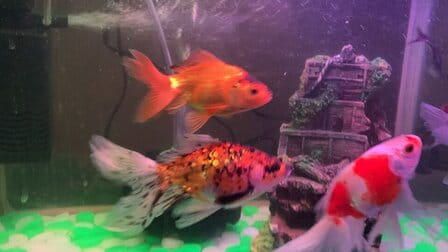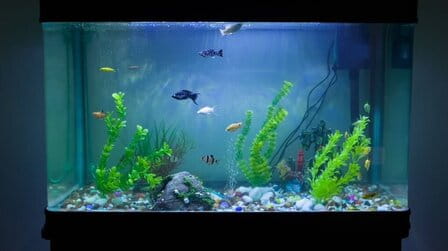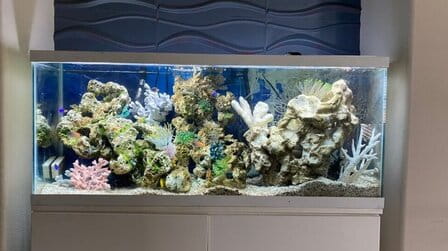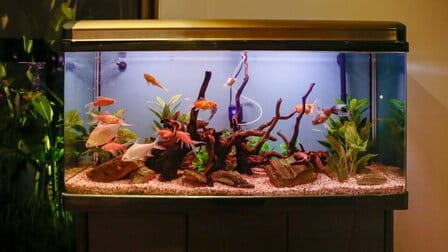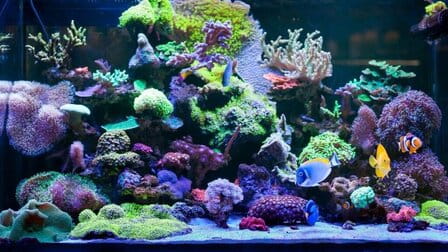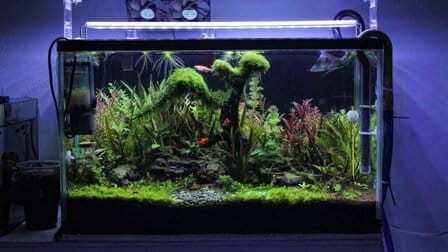Do you know why aquatic plants are of great benefit to the aquarium? Because it is a natural decoration, it also has many chemical and physical benefits and is very important when it comes to a healthy and thriving aquarium. According to some studies, aquarium plants are recommended for both novice and professional aquarists. To understand more about the benefits of live plants in aquariums, let's discuss them below!
1. Natural habitat
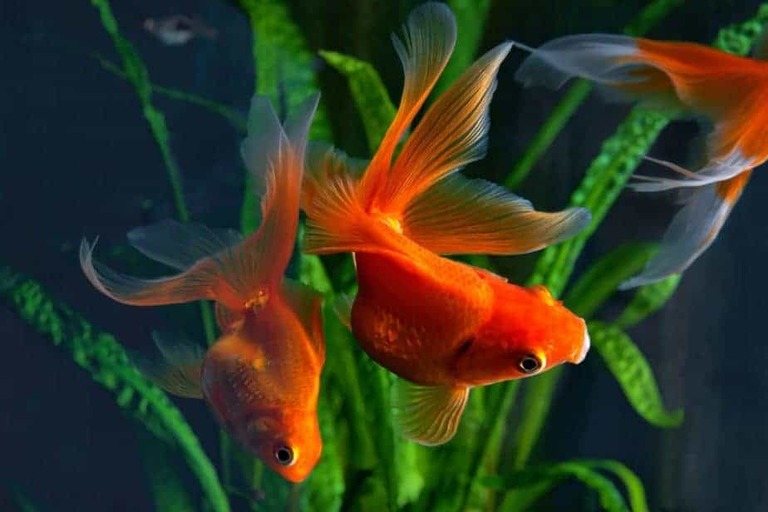
In general, the fish's natural habitat is inhabited by living plants. Therefore, planting some live plants in the aquarium helps to stimulate the fish's natural habitat.
2. Oxygen Supply

You can increase the oxygen in the aquarium, but increasing the oxygen still keeps the plants alive in the tank is a very natural way to do it.
Plants will increase the amount of oxygen in the aquarium.
Plants photosynthesize to make food, and in the process, they take in carbon dioxide and give off oxygen. As you know, carbon dioxide is very bad for fish and oxygen is very good for fish. So keeping live plants in the aquarium is a very good thing for fish. Especially at night, plants release carbon dioxide. Plants emit less carbon dioxide than they consume. You don't need to worry about the carbon dioxide released by plants that can harm fish.
3. Fish Food

Depending on the type of fish you choose different varieties. As Goldfish are omnivores, they eat non-vegetarian foods like insects, larvae, etc., and also need vegetarian food for the fish to grow properly.
From there, these fish have a non-vegetarian diet in the form of plants in their natural habitat.
Place certain plants in an aquarium containing these fish so that the fish can nibble on them.
Besides, there are some fish like silver dollar fish, Buenos Aires, and Tetras that can devour plants no matter how well you feed them.
4. Fish and Fry Sanctuary

It is known that live plants provide a very good hiding place for fry and small fish.
This will help protect you from large fish.
Furthermore, plants provide a kind of shelter for fish and fish often prefer to sleep in these shelters. It simply gives them a sense of security.
5. Reduce algae

Growing a live plant in your aquarium will help reduce algae in slow-growing aquariums.
The nutrients that the algae need to grow and the nutrients the plants need for their growth are roughly the same.
Plants are quite good at getting nutrients. So they starve the algae for nutrients that help reduce algae growth.
Anyway, you must take some other precautions to reduce algae growth. Like, don't leave the aquarium lights on for more than 12 hours.
Or you can grow live plants, do not use too strong or bright light at first or leave the light on less, maybe for 6 hours and then gradually increase as the plant grows.
That's why at first when the plant is very young, it doesn't need a lot of light.
If you keep the lights on for a longer time, the algae will take advantage and grow.
6. Health background

Plants are beneficial to the substrate health and overall health of the aquarium. It not only helps to break up the anaerobic pockets in the substrate but also prevents oxygen from reaching the depths of the substrate, anaerobic bacteria will form in these areas.
Almost there anaerobic bacteria produce hydrogen sulfide gas which is very toxic to fish. If the aquarium has a deep substrate then it is likely that this gas will accumulate in the area of the substrate below and will then release as bubbles into the tank, which is very harmful to the fish.
So roots grow deeper into the substrate, which will help break down these anaerobic pockets in the medium, ultimately solving the problem of hydrogen sulfide gas.
7. Help keeping the substrate in place

When planted in an aquarium, creating a hill and valley structure, the roots of the plant will help keep the substrate or soil in place as it forms.
From there, the structure created in the aquarium will remain the same and will not come off over time.
8. Filter added

You should remember any aquarium needs a very good filtration system to serve the growth of the fish.
While some filters maintain a healthy environment in the aquarium, plants provide a more natural filter.
Plants absorb all the unnecessary products such as nitrates, nitrites, ammonia, heavy metals, fish waste, and uneaten food.
Ultimately, all this unnecessary waste serves as fertilizer for the plants to help them grow.
9. Keep the water temperature low

Installing bright light in an aquarium generates a lot of heat, and plants can help lower the temperature in the tank.
Large trees like the Amazon sword will provide shade for part of the aquarium.
There are floating plants on the surface of the tank that will prevent direct sunlight from entering the tank and ultimately help maintain a lower temperature in the tank.
10. Promotes for the growth of beneficial bacteria

When placing plants in the aquarium, it will provide a lot of space for beneficial bacteria to live.
Some beneficial bacteria are good bacteria that help reduce ammonia levels in the aquarium. Because Ammonia is very harmful to your fish and a slight increase in ammonia levels in an aquarium can even cause fish death. Therefore, provide the right environment to create space for plants to grow.
11. Promotes reproduction and laying eggs

Fish will spawn in a certain environment in the wild. The time the plants come into play while creating the ideal environment for fish spawning. Several species of fish lay eggs on trees.
12. Fish aquarium decoration

The aquarium decoration allows you to decorate and personalize the aquarium and give it a unique and interesting look. Plants can make your aquarium look more natural. You can also mix different colored plants like red plants that look great with green plants.
Some floating plants and others tied to driftwood or substrate can bring variety to the aquarium and enhance its overall look of the aquarium.
13. Some ways to care for the live plant in an aquarium

First, you need to create a favorable environment and choose plants that are suitable for the water conditions that the fish require. So that plants can thrive in the aquarium.
Using substrates with most plants, you will need a medium to grow in the aquarium.
Then install a 2-3mm layer of fine gravel at the bottom which is ideal for planting in. In it, you can also use sand and some plants don't need any media like Java moss.
Assemble the lights, depending on the type of plant, you may require low, moderate, or high light. There will be some plants that need a good amount of light for them to grow properly, such as alfalfa, duckweed, water lily, and parrot feathers.
In addition, some plants require moderate light, such as stinging nettle, and Amazonian sword.
On the other hand, some plants can survive in very low light conditions, for example, Anubis, Java fern, and Java moss. So, arrange the light according to the needs of living plants for optimal growth.
Next, use fertilizer for optimal growth of aquatic plants. Make sure the fertilizer is fish-safe and iron-based. In particular, do not choose fertilizers with phosphate because it helps algae grow quickly.
Types of live plants in the aquarium
Some plants need to be tied to any decorations such as driftwood or substrate.
Some note:
- You can hang plants floating in the aquarium.
- Red plants if you want to make the aquarium look more colorful. However, they are quite difficult to maintain but they make the aquarium attractive.
- You should place large plants in the background of their aquarium and short plants in front of the aquarium.
- Putting some short plants in the background gives a nice depth effect to the tank.
Cryptocoryne wendtii
It is a small plant that can grow in any medium in all light conditions.
Marimo Moss. Orb
Is the little green ball. It's an alga but it looks good in Tank.
They don't require any maintenance and they can last in any light condition. Has a pretty cheap price.
You just throw it in the aquarium and then whenever the water changes, just move this ball a little so that the part at the bottom also has a light, or else it will die. Suitable in a Goldfish tank as Goldfish will move it around and they can also gnaw.
Aponogeton Crispus
This is also a relatively inexpensive, fast-growing species, so it is ideal for fish that like to gnaw on plants. You don't need any maintenance, you just need to put it on the substrate and it will grow on its own.
Java Moss
Unlike other plants, this one grows relatively quickly and is especially good for Goldfish as they can sometimes gnaw. We recommend this one.
Susswassertang
Suitable for live plant beginners, no need to tie it to any decorations or substrate. Just put it in the aquarium and it can survive in all conditions. However, they are hard to find and are not the cheapest plants.
Earn Amazon
This is the most common plant, growing very large and requires a deep medium for proper growth. They live in low to medium light conditions. Therefore, it is recommended to use some kind of fertilizer for fast plant growth.
Conclusion
Having said that, you already know there are many benefits of keeping live plants in an aquarium. There aren't any downsides to keeping live plants in the aquarium next to having to spend some time with them. If you choose to keep plants that need a good amount of light, you may have to buy some good lighting.

